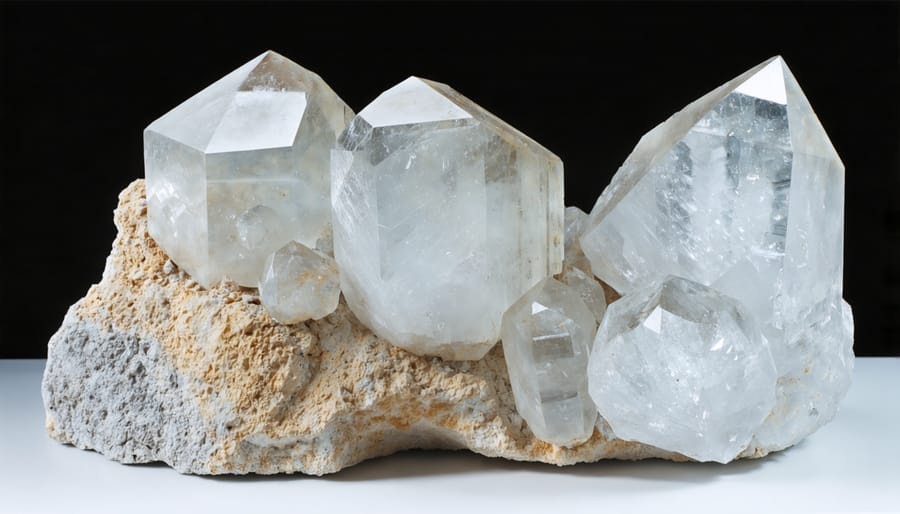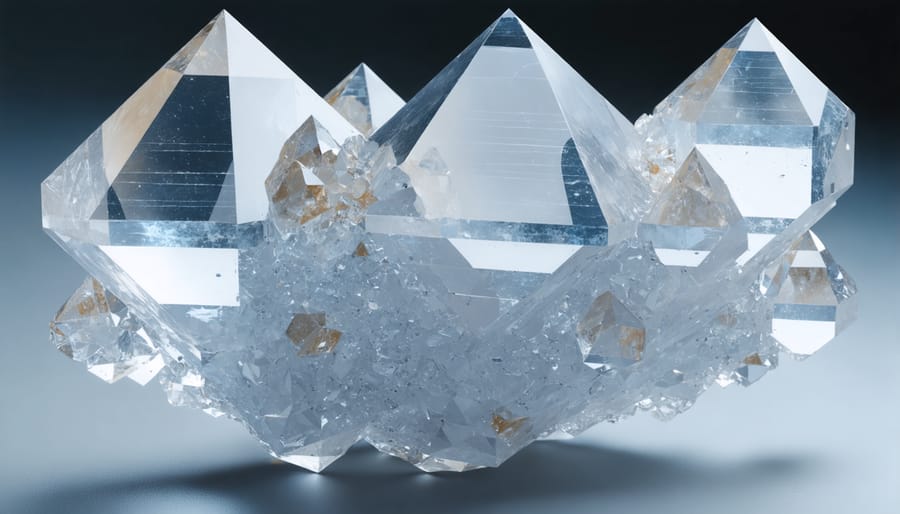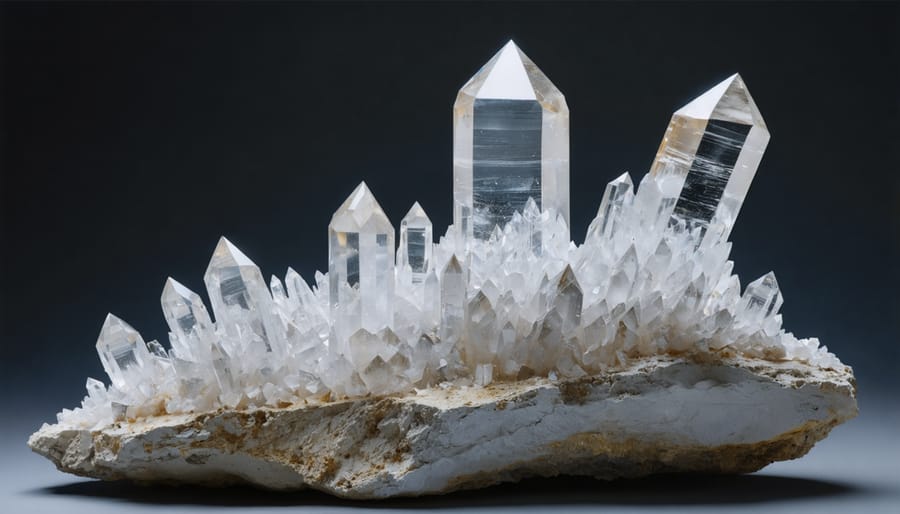Quartz stands as nature’s masterpiece of mineral engineering, ranking among the most common minerals in Earth’s crust and shaping landscapes across our planet. This crystalline form of silicon dioxide has withstood billions of years of geological processes, forming under intense pressure and temperature conditions that transform ordinary sand into spectacular crystalline structures. From the towering peaks of the Alps to the depths of ancient metamorphic formations, quartz tells the story of Earth’s dynamic past through its varied formations, colors, and structural properties. Its exceptional hardness of 7 on the Mohs scale, combined with its remarkable resistance to chemical weathering, makes it not just a geological marvel but also a cornerstone of human civilization – from ancient tools to modern electronic devices. Understanding quartz geology unlocks insights into Earth’s history while revealing why this mineral remains indispensable in both natural stone applications and technological advancement.
The Birth of Quartz: A Journey Through Time
Magmatic Formation
Quartz primarily forms during the magmatic rock formation process when molten rock slowly cools and crystallizes. As magma temperatures drop below 800°C (1,472°F), silicon and oxygen atoms begin organizing themselves into the distinctive hexagonal crystal structure of quartz. This crystallization typically occurs in granite formations, where quartz makes up approximately 20-60% of the rock composition.
The slow cooling rate is crucial for creating large, well-formed quartz crystals. When magma cools rapidly, the atoms don’t have sufficient time to arrange themselves properly, resulting in smaller crystals or glass-like formations. The presence of water and other volatile compounds in the magma also plays a vital role in quartz formation, as these elements help facilitate crystal growth.
Different cooling conditions and mineral compositions in the magma can produce various types of quartz, from clear crystal to colored varieties like amethyst and citrine. These variations occur when trace elements become incorporated into the crystal structure during formation.

Metamorphic Transformation
When exposed to intense heat and pressure deep within the Earth’s crust, quartz undergoes remarkable transformations that alter its crystal structure and appearance. This metamorphic process typically occurs at temperatures ranging from 150°C to 800°C and under significant pressure conditions, often during mountain-building events or deep burial.
During metamorphism, individual quartz crystals can recrystallize, creating interlocking grains that contribute to the formation of metamorphic rocks like quartzite. This transformed stone exhibits enhanced durability and strength compared to its parent material, making it highly valued in construction and architectural applications.
The degree of metamorphism directly influences quartz’s final characteristics. Under moderate conditions, quartz grains may simply recrystallize while maintaining their original composition. However, intense metamorphism can lead to the development of distinctive textures and patterns, such as foliation or banding, which are prized in decorative stone applications.
The presence of other minerals during metamorphism can result in unique color variations and patterns, creating aesthetically appealing natural stone products that showcase the dynamic forces of Earth’s geological processes.
Physical Properties That Make Quartz Special
Crystal Structure
Quartz’s crystal structure is a masterpiece of natural geometry, featuring a hexagonal system where silicon and oxygen atoms arrange themselves in a precise, repeating pattern. Each silicon atom bonds with four oxygen atoms, while each oxygen atom connects to two silicon atoms, creating the foundation of its distinctive SiO₂ formula. This molecular arrangement gives quartz its characteristic hardness of 7 on the Mohs scale and its exceptional durability.
The crystal structure exists in two main forms: alpha quartz (stable at room temperature) and beta quartz (stable at higher temperatures). This structural arrangement explains many of quartz’s valuable properties, including its resistance to weathering, its ability to transmit light, and its piezoelectric effect – the ability to generate an electrical charge under pressure.
Understanding quartz’s crystal structure is crucial for both industrial applications and construction uses. The strong silicon-oxygen bonds make quartz highly resistant to chemical and physical weathering, explaining why quartz-rich rocks often form prominent landscape features and why quartz-based materials are so durable in building applications. This molecular architecture also accounts for quartz’s ability to resist scratching and maintain its appearance over time.

Hardness and Durability
Quartz ranks 7 out of 10 on the Mohs scale of mineral hardness, making it one of the most durable naturally occurring minerals on Earth. This exceptional hardness means quartz can scratch most common materials, including glass and steel, while being resistant to scratching from everyday items. Only minerals like topaz, corundum, and diamond rank higher in hardness.
This inherent durability makes quartz highly valued in construction and design applications. In its natural form, quartz withstands weathering and erosion better than most minerals, which explains why it’s so abundant in sand and why quartz-rich rocks maintain their structure over millions of years. In engineered applications, such as countertops and floor tiles, quartz’s hardness translates to exceptional scratch resistance and longevity.
Despite its hardness, quartz can still break along cleavage planes when subjected to strong impact. However, this characteristic rarely affects its performance in typical applications, where its resistance to abrasion and chemical weathering proves more relevant. These properties have made quartz a go-to material for both decorative and functional uses throughout human history.
Global Deposits and Varieties
Major Quartz Deposits
Quartz deposits are found extensively across the globe, with some regions notably rich in high-quality formations. Brazil stands as a world leader in quartz production, particularly in the states of Minas Gerais and Bahia, where crystal-clear specimens regularly exceed several tons in weight. The Arkansas region in the United States, specifically Mount Ida and Hot Springs areas, is renowned for its premium quartz crystals, earning the nickname “The Quartz Crystal Capital of the World.”
Madagascar hosts significant deposits of rose quartz, while the Swiss Alps are famous for their smoky quartz formations. In Australia, the Palmer River region of North Queensland contains substantial deposits of both clear and smoky quartz varieties. China’s Yunnan Province and India’s Karnataka state are major commercial sources, supplying much of the world’s industrial-grade quartz.
The Namibian desert presents unique quartz formations, including the spectacular rose quartz deposits near Rossing. In Europe, significant deposits exist in the Scottish Highlands and throughout the Alpine regions. These major deposits vary in quality and characteristics, with some primarily serving industrial purposes while others yield gem-quality crystals sought after by collectors and jewelry makers worldwide.

Natural Quartz Varieties
Quartz appears in nature in a stunning array of natural quartz varieties and colors, each with distinct characteristics that make them valuable for different applications. The most common variety is clear or white quartz, often found in massive formations. Amethyst, with its signature purple hue, ranges from pale lilac to deep violet due to iron impurities and radiation exposure. Citrine displays warm yellow to honey-brown tones, while Rose Quartz offers a delicate pink coloration attributed to titanium, iron, or manganese content.
Smoky Quartz exhibits various brown to black shades, caused by natural radiation affecting aluminum impurities within the crystal structure. Tiger’s Eye, featuring a distinctive chatoyant effect, displays golden-brown bands with a silk-like luster. Aventurine, typically green but also occurring in blue or orange, contains small inclusions that create a sparkling effect known as aventurescence.
Other notable varieties include Prasiolite (green quartz), Rutilated Quartz (containing needle-like rutile inclusions), and Milky Quartz (with its characteristic cloudy white appearance). Each variety’s unique properties and appearance make them sought-after for both decorative and practical applications in architecture and design.
From Earth to Architecture
The journey of quartz from its natural state to construction materials begins with careful extraction from quarries. Large blocks of quartz-rich stone are removed using controlled blasting techniques and diamond-wire cutting methods that minimize waste and maintain the stone’s structural integrity.
Once extracted, the raw quartz undergoes several processing stages. Initial processing involves cutting the large blocks into more manageable sizes using giant saws equipped with diamond-tipped blades. These smaller blocks are then further processed based on their intended use, whether for countertops, floor tiles, or decorative elements.
Surface finishing is a crucial step that determines the final appearance and functionality of quartz products. Common finishing techniques include polishing to achieve a glossy surface, honing for a matte finish, or texturing for enhanced grip in flooring applications. Modern technology allows for precise control over these processes, ensuring consistent quality across large production runs.
In recent years, engineered quartz has gained popularity in construction. This material combines crushed natural quartz (typically 90-95%) with resins and pigments under high pressure and heat. The result is a highly durable, non-porous surface that maintains the aesthetic appeal of natural stone while offering improved performance characteristics.
Quality control is maintained throughout the production process through rigorous testing of physical properties, including hardness, density, and resistance to staining. This ensures that the final products meet construction industry standards and architectural specifications. The finished materials are then carefully packaged and transported to distribution centers or directly to construction sites, ready for installation in various architectural applications.
Quartz stands as one of nature’s most remarkable and abundant minerals, playing a crucial role in both geological processes and modern applications. Its exceptional durability, versatility, and aesthetic appeal make it an invaluable material in construction, design, and various industrial uses. From its formation deep within the Earth’s crust to its presence in contemporary architecture, quartz demonstrates the seamless connection between natural geological processes and human innovation.
Understanding quartz geology helps professionals and consumers make informed decisions about natural stone applications. Its superior hardness, resistance to chemical weathering, and variety of appearances – from crystalline formations to compact varieties – offer solutions for diverse project requirements. The mineral’s abundance and sustainable extraction methods also make it an environmentally conscious choice for modern construction.
As we continue to develop new technologies and applications, quartz remains at the forefront of natural stone materials, bridging the gap between Earth’s geological heritage and contemporary design needs. Its timeless appeal and proven performance ensure its continued significance in both natural and engineered stone applications for generations to come.










